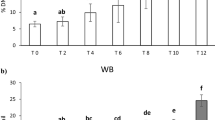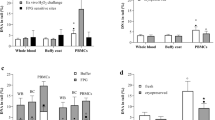Abstract
Objective: The aim of this study was to determine low molecular weight (LMW)-DNA fragmentation changes after white blood cell (WBC) incubation in lysis buffer followed by constant-field gel electrophoresis (CFGE). WBCs were isolated from blood samples of workers highly exposed to asbestos fibres at the workplace in Germany, and were compared with those from healthy adults. This study was conducted parallel to the study presented in our preceding paper (Marczynski et al. 2000b) in which we described significant increases in the levels of 8-hydroxy-2′-deoxyguanosine (8-OHdG) adducts in the DNA of white blood cells from the same highly exposed workers relative to the levels found in the control group in all three study years (1994 to 1997). Method: We found that 15-h incubation in lysis buffer of WBCs embedded in agarose-plugs from healthy control donors with 2% SDS, proteinase K and Na2-EDTA at 42 °C followed by 0.5 h at 4 °C produced a characteristic DNA fragmentation pattern below 23 kbp using CFGE. Results: In the 1st year of the study (1994–1995) changes were found in LMW-DNA fragmentation in 54.8% of the asbestos workers studied, compared with the DNA fragmentation pattern of controls. Interestingly, in the 2nd year of the study (1995–1996) changes in DNA fragmentation were found in only 39.9% of exposed subjects. In the 3rd year of the study (1996–1997) the highest number of workers exposed to asbestos (67.3%) with changes in the LMW-DNA fragmentation pattern was found. The Chi-square test for each year of the study revealed significant changes (P < 0.001). These changes may be due to the presence of hydrogen peroxide (H2O2), as has been shown in vitro. It is likely that a Fenton reaction involving the heterolytic reduction of H2O2 by traces of reduced transition metals such as Fe2+ and Cu+ is involved in the fragmentation of DNA. No difference was found in the changes in DNA fragmentation between asbestos-exposed subjects with and without benign asbestos-associated diseases (asbestosis, asbestos-associated pleural plaques). Significant correlations were not found after analysis of the changes in DNA fragmentation in relation to different possible occupational and non-occupational confounding factors, such as the duration of asbestos exposure, the latency period, estimated cumulative fibrous dust dose (“fibre-years”), and non-occupational confounding factors, such as age, smoking status, acute febrile infections, the intake of medicines, aspirin, Ca2+, Mg2+ and/or hormones, the intake of vitamins, and cases of cancer. Conclusions: Our data confirm that oxidative stress occurs in the WBCs of workers highly exposed to asbestos fibres, thus supporting the hypothesis that asbestos fibres damage cells through an oxidative mechanism. Oxidative stress and oxidative DNA damage may be induced by long-term exposure to asbestos. The new insights into the oxidative effects of asbestos fibres are of great importance because they provide a way forward for new preventive strategies. Preventive and therapeutic approaches using antioxidants should be taken into consideration.
Similar content being viewed by others
Author information
Authors and Affiliations
Additional information
Received: 2 October 2000 / Accepted: 27 January 2001
Rights and permissions
About this article
Cite this article
Marczynski, B., Kraus, T., Rozynek, P. et al. Changes in low molecular weight DNA fragmentation in white blood cells of workers highly exposed to asbestos. Int Arch Occup Environ Health 74, 315–324 (2001). https://doi.org/10.1007/PL00007949
Issue Date:
DOI: https://doi.org/10.1007/PL00007949




